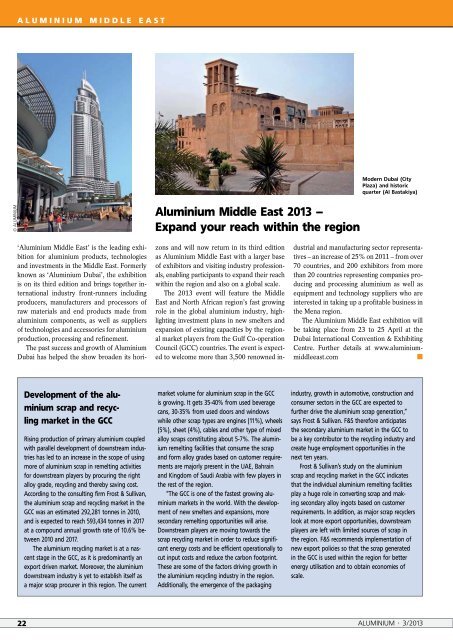special - Alu-web.de
special - Alu-web.de
special - Alu-web.de
Create successful ePaper yourself
Turn your PDF publications into a flip-book with our unique Google optimized e-Paper software.
ALUMINIUM MI DDL E EAST<br />
Mo<strong>de</strong>rn Dubai (City<br />
Plaza) and historic<br />
quarter (Al Bastakiya)<br />
© ALUMINIUM<br />
<strong>Alu</strong>minium Middle East 2013 –<br />
Expand your reach within the region<br />
‘<strong>Alu</strong>minium Middle East’ is the leading exhibition<br />
for aluminium products, technologies<br />
and investments in the Middle East. Formerly<br />
known as ‘<strong>Alu</strong>minium Dubai’, the exhibition<br />
is on its third edition and brings together international<br />
industry front-runners including<br />
producers, manufacturers and processors of<br />
raw materials and end products ma<strong>de</strong> from<br />
aluminium components, as well as suppliers<br />
of technologies and accessories for aluminium<br />
production, processing and refinement.<br />
The past success and growth of <strong>Alu</strong>minium<br />
Dubai has helped the show broa<strong>de</strong>n its horizons<br />
and will now return in its third edition<br />
as <strong>Alu</strong>minium Middle East with a larger base<br />
of exhibitors and visiting industry professionals,<br />
enabling participants to expand their reach<br />
within the region and also on a global scale.<br />
The 2013 event will feature the Middle<br />
East and North African region’s fast growing<br />
role in the global aluminium industry, highlighting<br />
investment plans in new smelters and<br />
expansion of existing capacities by the regional<br />
market players from the Gulf Co-operation<br />
Council (GCC) countries. The event is expected<br />
to welcome more than 3,500 renowned in-<br />
dustrial and manufacturing sector representatives<br />
– an increase of 25% on 2011 – from over<br />
70 countries, and 200 exhibitors from more<br />
than 20 countries representing companies producing<br />
and processing aluminium as well as<br />
equipment and technology suppliers who are<br />
interested in taking up a profitable business in<br />
the Mena region.<br />
The <strong>Alu</strong>minium Middle East exhibition will<br />
be taking place from 23 to 25 April at the<br />
Dubai International Convention & Exhibiting<br />
Centre. Further <strong>de</strong>tails at www.aluminiummiddleeast.com<br />
■<br />
Development of the aluminium<br />
scrap and recycling<br />
market in the GCC<br />
Rising production of primary aluminium coupled<br />
with parallel <strong>de</strong>velopment of downstream industries<br />
has led to an increase in the scope of using<br />
more of aluminium scrap in remelting activities<br />
for downstream players by procuring the right<br />
alloy gra<strong>de</strong>, recycling and thereby saving cost.<br />
According to the consulting firm Frost & Sullivan,<br />
the aluminium scrap and recycling market in the<br />
GCC was an estimated 292,281 tonnes in 2010,<br />
and is expected to reach 593,434 tonnes in 2017<br />
at a compound annual growth rate of 10.6% between<br />
2010 and 2017.<br />
The aluminium recycling market is at a nascent<br />
stage in the GCC, as it is predominantly an<br />
export driven market. Moreover, the aluminium<br />
downstream industry is yet to establish itself as<br />
a major scrap procurer in this region. The current<br />
market volume for aluminium scrap in the GCC<br />
is growing. It gets 35-40% from used beverage<br />
cans, 30-35% from used doors and windows<br />
while other scrap types are engines (11%), wheels<br />
(5%), sheet (4%), cables and other type of mixed<br />
alloy scraps constituting about 5-7%. The aluminium<br />
remelting facilities that consume the scrap<br />
and form alloy gra<strong>de</strong>s based on customer requirements<br />
are majorly present in the UAE, Bahrain<br />
and Kingdom of Saudi Arabia with few players in<br />
the rest of the region.<br />
“The GCC is one of the fastest growing aluminium<br />
markets in the world. With the <strong>de</strong>velopment<br />
of new smelters and expansions, more<br />
secondary remelting opportunities will arise.<br />
Downstream players are moving towards the<br />
scrap recycling market in or<strong>de</strong>r to reduce significant<br />
energy costs and be efficient operationally to<br />
cut input costs and reduce the carbon footprint.<br />
These are some of the factors driving growth in<br />
the aluminium recycling industry in the region.<br />
Additionally, the emergence of the packaging<br />
industry, growth in automotive, construction and<br />
consumer sectors in the GCC are expected to<br />
further drive the aluminium scrap generation,”<br />
says Frost & Sullivan. F&S therefore anticipates<br />
the secondary aluminium market in the GCC to<br />
be a key contributor to the recycling industry and<br />
create huge employment opportunities in the<br />
next ten years.<br />
Frost & Sullivan’s study on the aluminium<br />
scrap and recycling market in the GCC indicates<br />
that the individual aluminium remelting facilities<br />
play a huge role in converting scrap and making<br />
secondary alloy ingots based on customer<br />
requirements. In addition, as major scrap recyclers<br />
look at more export opportunities, downstream<br />
players are left with limited sources of scrap in<br />
the region. F&S recommends implementation of<br />
new export policies so that the scrap generated<br />
in the GCC is used within the region for better<br />
energy utilisation and to obtain economies of<br />
scale.<br />
22 ALUMINIUM · 3/2013
















